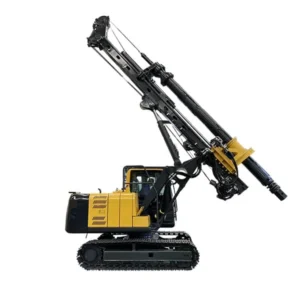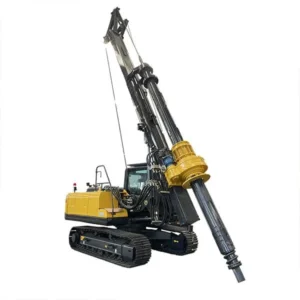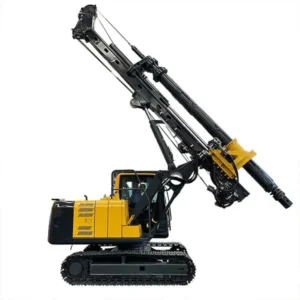When it comes to drilling projects, the mini rotary drilling rig is a versatile and essential piece of equipment. These compact machines are designed to perform various drilling tasks with precision and efficiency. However, like any machinery, mini rotary drilling rigs can encounter issues that may hinder their performance. In this comprehensive guide, we will explore common problems faced by users of mini rotary drilling rigs and provide solutions to keep your operations running smoothly.
Introducción

Mini rotary drilling rigs are widely used in construction, mining, and geotechnical applications due to their compact size and efficiency. They are ideal for drilling in tight spaces and performing tasks that larger rigs cannot handle. Despite their advantages, users often encounter issues that can disrupt their projects. This guide aims to address these common problems and provide practical solutions to ensure your mini rotary drilling rig operates at peak performance.
Tabla de contenido
Understanding Mini Rotary Drilling Rigs
Before diving into common issues, it is essential to understand the basic components and functions of a mini rotary drilling rig. These rigs typically consist of the following parts:
- Drill Head: The part of the rig that holds and rotates the drill bit.
- Drill Bit: The cutting tool that penetrates the ground.
- Mast: The vertical structure that supports the drill head and drill bit.
- Hydraulic System: Powers the movements of the rig.
- Control Panel: Allows the operator to control the drilling process.
Understanding these components will help you identify and troubleshoot issues more effectively.
Common Issues with Mini Rotary Drilling Rigs
Hydraulic System Failures
The hydraulic system is the heart of a mini rotary drilling rig. It powers the movements of the drill head, mast, and other components. Common issues include:
- Hydraulic Fluid Leaks: Caused by damaged seals or hoses.
- Calentamiento excesivo: Due to continuous operation or insufficient cooling.
- Low Pressure: Resulting from clogged filters or pump failures.
Drill Bit Wear and Tear
The drill bit is subjected to extreme forces and abrasive materials, leading to:
- Dulling: The bit loses its sharpness, reducing efficiency.
- Breakage: Caused by hitting hard objects or excessive force.
- Corrosion: Due to exposure to moisture and chemicals.
Mast Misalignment
The mast must be perfectly aligned to ensure accurate drilling. Common alignment issues include:
- Bent Mast: Due to improper handling or accidents.
- Loose Bolts: Causing the mast to wobble.
- Foundation Instability: Leading to uneven mast alignment.
Power Supply Problems
Mini rotary drilling rigs require a reliable power source. Common issues include:
- Battery Failures: Due to insufficient charging or old batteries.
- Generator Malfunctions: Resulting from lack of maintenance or overloads.
- Electrical Faults: Including wiring issues and blown fuses.
Control Panel Malfunctions
The control panel is critical for operating the rig. Issues here can severely impact performance:
- Unresponsive Controls: Due to software glitches or hardware failures.
- Display Errors: Making it difficult to monitor operations.
- Calibration Issues: Leading to inaccurate drilling.
Table: Common Issues and Solutions for Mini Rotary Drilling Rigs
To help you address these issues, we have compiled a table of common problems and their solutions:
| Issue | Symptoms | Possible Causes | Solutions |
|---|---|---|---|
| Hydraulic Fluid Leaks | Fluid pooling under the rig | Damaged seals, cracked hoses | Inspect and replace seals or hoses |
| Calentamiento excesivo | Excessive heat, system shutdown | Continuous operation, insufficient cooling | Allow cooling periods, check cooling system |
| Low Pressure | Slow movements, weak drilling force | Clogged filters, pump failure | Clean or replace filters, inspect and repair pump |
| Dulling Drill Bit | Slow drilling, increased effort | Normal wear and tear | Sharpen or replace the drill bit |
| Drill Bit Breakage | Sudden stop, broken bit pieces | Hitting hard objects, excessive force | Use appropriate bit for material, reduce drilling force |
| Corroded Drill Bit | Rust, reduced efficiency | Exposure to moisture, chemicals | Clean and lubricate bit, use corrosion-resistant bits |
| Bent Mast | Uneven drilling, visible bend | Improper handling, accidents | Inspect and repair/replace mast |
| Loose Mast Bolts | Wobbling mast, alignment issues | Vibration, poor maintenance | Tighten bolts, regular maintenance checks |
| Foundation Instability | Mast misalignment, uneven drilling | Unstable ground, improper setup | Ensure stable and level foundation |
| Battery Failures | Power loss, slow start | Old batteries, insufficient charging | Replace batteries, ensure proper charging |
| Generator Malfunctions | Power interruptions, loud noises | Lack of maintenance, overload | Regular maintenance, avoid overloading |
| Electrical Faults | Unresponsive rig, blown fuses | Wiring issues, short circuits | Inspect wiring, replace blown fuses |
| Unresponsive Controls | Controls not working, delayed response | Software glitches, hardware failure | Restart system, update software, inspect hardware |
| Display Errors | Inaccurate readings, screen flickering | Display malfunction, connection issues | Inspect and repair/replace display unit |
| Calibration Issues | Inaccurate drilling, misaligned holes | Incorrect settings, sensor issues | Recalibrate system, check sensor connections |
Maintenance Tips for Mini Rotary Drilling Rigs

Regular maintenance is crucial to keep your mini rotary drilling rig in top condition. Here are some maintenance tips to prevent common issues:
Regular Inspection
Perform regular inspections of all components, including the hydraulic system, drill bit, mast, and control panel. Look for signs of wear and tear, leaks, and misalignment.
Lubrication
Keep moving parts well-lubricated to reduce friction and prevent corrosion. Use the appropriate lubricants recommended by the manufacturer.
Cleaning
Clean the rig regularly to remove dirt, debris, and contaminants that can cause damage. Pay special attention to the hydraulic system and drill bit.
Replace Worn Parts
Replace worn or damaged parts promptly to prevent further damage and ensure optimal performance. Keep a stock of commonly replaced parts, such as seals, hoses, and drill bits.
Follow Manufacturer Guidelines
Adhere to the maintenance guidelines provided by the manufacturer. This includes following recommended service intervals, using specified parts and fluids, and conducting routine checks.
Troubleshooting Common Problems
Despite regular maintenance, issues can still arise. Here are some troubleshooting tips for common problems with mini rotary drilling rigs:
Hydraulic System Troubleshooting
- Symptom: Slow movements or weak drilling force.
- Possible Cause: Low hydraulic fluid levels.
- Solution: Check fluid levels and refill if necessary. Inspect for leaks.
Drill Bit Troubleshooting
- Symptom: Slow drilling or excessive effort.
- Possible Cause: Dull or damaged drill bit.
- Solution: Sharpen or replace the drill bit.
Mast Troubleshooting
- Symptom: Uneven drilling or visible mast bend.
- Possible Cause: Bent mast or loose bolts.
- Solution: Inspect and repair or replace the mast. Tighten bolts.
Power Supply Troubleshooting
- Symptom: Power loss or slow start.
- Possible Cause: Battery failure or generator malfunction.
- Solution: Replace batteries, ensure proper charging, perform generator maintenance.
Control Panel Troubleshooting
- Symptom: Unresponsive controls or display errors.
- Possible Cause: Software glitches or hardware failure.
- Solution: Restart system, update software, inspect and repair hardware.
Conclusión
Mini rotary drilling rigs are versatile and powerful machines essential for various drilling tasks. By understanding common issues and implementing the solutions provided in this guide, you can ensure your rig operates smoothly and efficiently. Regular maintenance, proper inspection, and timely troubleshooting are key to maximizing the lifespan and performance of your mini rotary drilling rig. Don’t get stuck—stay proactive and keep your drilling operations running seamlessly.
Preguntas Frecuentes
What is the typical lifespan of a mini rotary drilling rig?
The lifespan of a mini rotary drilling rig depends on usage, maintenance, and operating conditions. With proper care, these rigs can last for many years, often exceeding a decade of service.
How often should I service my mini rotary drilling rig?
Regular maintenance is crucial for longevity. Follow the manufacturer’s recommended service intervals, typically every 200-500 hours of operation, depending on the model and usage intensity.
What should I look for when buying a used mini rotary drilling rig?
When buying a used mini rotary drilling rig, check the engine condition, hydraulic system, attachment compatibility, and overall wear and tear. Request maintenance records and conduct a thorough inspection.
How can I prevent hydraulic system failures?
Prevent hydraulic system failures by performing regular inspections, keeping the system clean, and using the correct hydraulic fluid. Monitor fluid levels and replace filters as needed.
Are mini rotary drilling rigs suitable for all types of terrain?
Mini rotary drilling rigs are designed to handle various terrains, but it’s important to choose a model that matches the specific requirements of your terrain. Consider factors like engine power, hydraulic capacity, and stability.








-150x150.webp)
